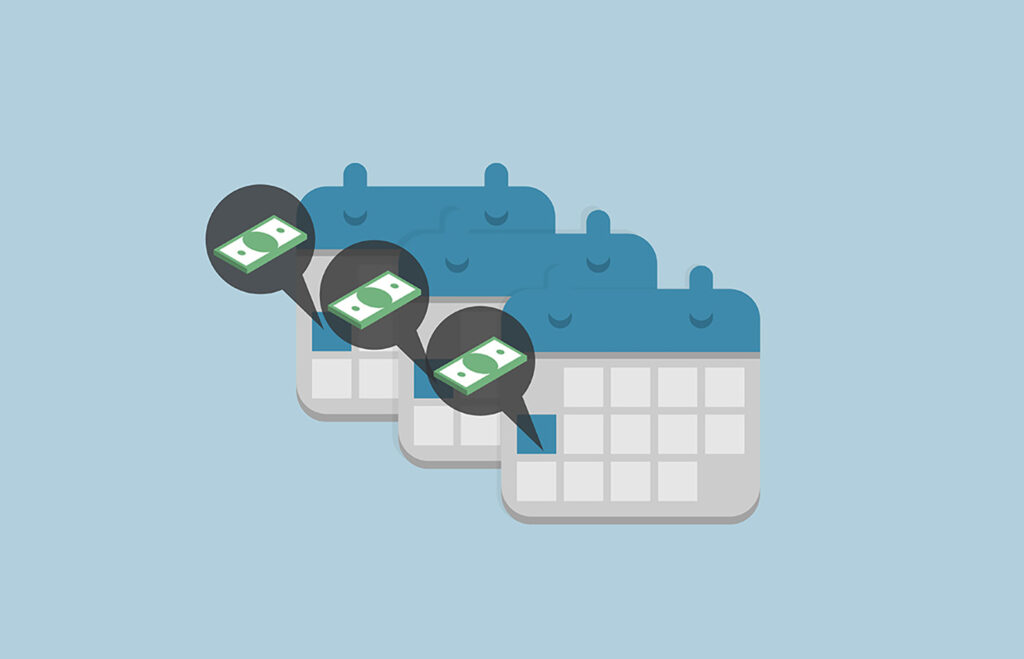SaaS (software-as-a-service) startups are an exciting place to be. Pulsing with energy, they’re hives of hard work, excitement, and pure gratitude for each and every customer that opts for their product.
But as time moves on and the business scales, something shifts.
The excitement and gratitude are still there, but they become burdened ever so slightly with a new experience: growing pains.
There comes a time in every subscription SaaS business’s life when its previous manual processes no longer do the trick. That’s why digital transformation spending is estimated to double in the next four years. Processes need to be streamlined, automated, and optimized to enable continued scalability.
A SaaS business’s billing engine is a prime example.
Not only does it ensure the maintenance of healthy cash flow, but it also supports a business’s entire revenue operations. Marketing brings in the leads, sales closes them, and then if your business doesn’t have an efficient way to capture the recurring payments from your customers, you’re going to have a revenue problem.
TL;DR
- Recurring payments are the foundation of subscription model businesses. Running these payments manually will eventually grow to be time-intensive and costly for a company to grow without automating billing.
- Choosing a payment provider to support your automated billing requires evaluating a solution both on what it offers you now and how it can continue to support your business as it scales.
- Once you’ve gotten your automated billing up and running, you should set up ongoing security protocols to avoid exposing your company and customers to data breaches. These security protocols should include auditing systems regularly and establishing clear protocols around data retention.
- Many businesses have made the leap from manual billing to automated and have not only saved themselves weeks of work a month – but they’ve discovered revenue leaks they didn’t know they had.
What are recurring payments?
Fixed recurring payments are automatic payments that occur on a regular recurring basis, typically monthly or annually. They allow customers to authorize a business to automatically charge their payment method on a regular basis, rather than forcing them to checkout every billing cycle, re-entering billing information. (This payment method can typically be most non-cash methods like card payments, ACH payments and even PayPal.) Once authorized, the payment details are securely stored by the business or a payment processor, and the agreed-upon amount is deducted from the customer’s account at the specified intervals without the need for manual intervention.
Common places you’ve encountered subscription businesses or other businesses that accept recurring payments:
- Streaming services like Netflix are a notable example of subscription-based services.
- A much more established example is the gym membership.
- Magazine subscriptions have also run recurring billing for many years.
There are a variety of benefits of recurring payments. The main benefit for customers of course, is that recurring payments increase convenience for the customer, reducing hassle and improving the customer experience. For businesses, a subscription model provides a predictable revenue stream and increase customer retention.
Recurring payments are the basis of SaaS business models. (Previously, software customers would make a one-time purchase of a version of a software that they would then own forever. If they wanted to upgrade that software, they’d have to purchase the upgrade with a separate one-time payment.) In order for SaaS businesses to run recurring payments, they need to be able to store a customer’s plan and payment information, as well as then charge the payment method regularly. To do that, most (if not all) SaaS companies turn to payment providers who are capable of doing this complex work.
When that day arrives for your business to transform its recurring billing and payments solution—and perhaps it already has—it’s important to follow the right steps to get your business set up with a digital transformation effort that suits its needs.
1. Know when it’s time to automate your recurring subscription payments process.
It’s very easy for bottlenecks to sneak up on your business.
In the beginning, manual invoicing and payment processing are manageable by hand. But for most businesses, this begins to change around the 150 to 200 customer-mark.
Even then, however, it can be difficult to recognize the signs telling you to automate. Here are a few symptoms that show it’s time for a change.
- You’re inflexible: It’s hard to adjust your pricing plans or offer custom plans and subscriptions quickly when everything is done by hand. Worse yet, while you lag behind, swifter competitors pick up business.
- Your billing department is overwhelmed: A staggering 80% of tech workers report feeling burned out. The billing department of a rapidly growing subscription SaaS business is sure to fall within this category. The equation is pretty simple: when workloads double or even triple from quarter to quarter, or even month to month, it’s a problem.
- Mistakes are being made: Stress isn’t the only symptom of an overworked subscription billing department. Before too long that stress will begin to result in errors. Employees feel rushed, corners get cut (by necessity), and accuracy takes a hit. Unfortunately, mistakes also come at the cost of customers and their experience. No one is happy when they receive a bill riddled with errors. And of course, errors often result in revenue leakage for your business.
2. Choose the right solution to automate your subscription billing and recurring payments.
Once you’ve come to the understanding you need to change the way you handle recurring payments, it’s time to start thinking about what solution’s right for you. This means taking a survey of your billing and collections requirements and selecting an option that fits.
You need a solution that transforms your business model now, as well as how you expect it to develop in the years to come.
- What kind of recurring billing and payments system are you looking for?
- Are you looking to run online payments?
- What sorts of payment options do you accept? Debit cards? Direct debit? Credit cards?
- Do you need to be able to process refunds?
- Do you bill monthly? Quarterly? Annually?
- And what other tools will your solution need to integrate with?
Digital transformation comes with the promise of greater efficiency, but this is only true if your tools can work together seamlessly. To that end, the best billing and payment system in the world might still produce frustration if it doesn’t fit well with the rest of your tech stack.
It’s also worth mentioning a modern, automated billing platform can do more than just what its name implies, including:
- hosted registration and self-service subscription management
- customer communications automation
- seamless subscription migrations and account updates
- robust recurring revenue reporting
- accurate revenue recognition for simplified month-end-close,
- and lots more.
It takes a truly comprehensive billing platform to satisfy the needs of a growing SaaS business. Integrating the right software now supports business operations of the present while also enabling barrier-free scalability for the future.
Tips to evaluate a payment solution for scalability
- Perhaps most obviously, assess whether the payment solution can handle increased transaction volumes as your customer base grows. Consider factors such as processing speed, reliability, and the ability to scale resources seamlessly to meet demand spikes during peak periods.
- Look for payment solutions that offer flexibility to accommodate changes in your business model, such as adding new subscription plans, adjusting pricing tiers, or expanding into new markets. Ensure that the solution can adapt to evolving needs without requiring significant reconfiguration or customization.
- Look into the provider’s integration capabilities. Do they have a huge library of built-in apps? Do they offer an API that allows you to integrate your own tools? You likely will change the tools in your tech stack as you grow, so it’s key to ensure that your payment provider can continue to plug in to future possibilities.
- If you plan to expand globally, choose a payment solution that supports multiple currencies, languages, and payment methods. Ensure compatibility with local regulations and compliance requirements in target markets to facilitate smooth expansion without encountering payment processing obstacles.
- Consider how the pricing model of a payment solution will affect your business as it grows. Certain payment structures work well for businesses that don’t run many transactions, but become very expensive as you run more and more transactions.
3. Set up an effective dunning management process.
Once you have an automated platform in place to handle your recurring billing and recurring payments processes, you’ll want to use it to set up an effective dunning management strategy. Failed customer payments become costly, but with the right tools, you can help nip revenue leakage in the bud. Collections assurance matters.
Modern automated billing platforms enable you to automate credit card retries and dunning email campaigns while also giving your customers easy access to fixing the problems themselves through self-service portals.
Often, collection issues are the result of an honest mistake. Maybe the customer’s credit card expired. Maybe they changed providers. Maybe their bank account dipped too low at the time they were billed.
When these minor issues crop up it’s easy to end a relationship with a customer that would have stayed on if given the chance. The right tools allow for a different approach, and retaining customers is everything in the world of SaaS.
By addressing the issue directly, you not only collect the money you’re owed, but you also preserve the relationship, and as a result, your MRR.
Keep in mind up to 39% of invoices are paid late in the United States. Often, it’s a business’s dunning management strategy that makes the difference between late payments and no payments at all.
4. Integrate with the right payment gateway provider.
Payment gateway providers tend to look very similar on paper. After all, their job is to facilitate transactions and how much variety can there be to that?
But differences do exist and can have a pretty big impact on what sort of experience your business has when it comes to managing recurring payments.
For example, gateway providers can vary substantially in how they apply fees to each merchant account. It’s normal for them to make their money through a combination of transaction fees and flat rates. However, beyond that point, each option may handle things differently.
- Annual fees
- customer service fees
- setup fees, and
- statement fees are all “hidden” methods that some providers use to pad their bills.
If you find a company with these or similar policies stated in their paperwork, it’s likely best to avoid them.
There are also subtle variations to how the payment provider functions. Hosted gateway providers take your customers back to their own site to handle payments. This method can be easy for startups because it doesn’t take much reworking on their part. However, it also creates a small detour for customers that comes at the cost of their time and experience. It also takes up time for your finance team to work back and forth between the two different platforms.
Integrated recurring payment gateway providers, on the other hand, work seamlessly within your website. Integration should be quick and easy through your automated billing provider, and the difference will serve your customers well.
5. Improve the collections assurance on your recurring payments.
Sometimes automated dunning processes, no matter how good, are ineffective. When this happens, additional actions may be required.
Your new recurring billing platform can also be used to improve your collections on aging accounts receivables by providing laser-focused reports and tracking capability. Using an aging accounts receivable widget you can view:
- who owes you payments
- how much they owe
- how many invoices they are behind, and
- how long the issue has been going on so you can determine what your chances are of collecting.
This detailed reporting makes it significantly easier for billing clerks to reach out specifically to customers that are behind for more personalized payment retrieval attempts.
Bonus step: Create security protocols specific to recurring billing
Recurring payment systems present unique security considerations due to the ongoing nature of transactions and the storage of sensitive customer data. In order to avoid costly data breaches and worse, you need to implement a variety of security protocols:
- If utilizing card account updater (CAU) services to automatically update expired or replaced card details, ensure that these services comply with stringent security standards. Validate the security practices of CAU providers and monitor for any unauthorized access or misuse of updated card information.
- Verify the integrity of billing schedules to prevent unauthorized changes or tampering with recurring payment frequencies or amounts. Implement access controls and audit trails to monitor and track modifications to billing schedules, ensuring compliance with customer preferences and regulatory requirements.
- Develop secure payment retry logic to handle failed recurring payment attempts while safeguarding customer data and preventing fraudulent activity. Implement mechanisms to detect and respond to suspicious payment retry patterns, such as excessive retry attempts or unusual payment intervals.
- Establish clear data retention policies for recurring payment systems to govern the storage and deletion of customer payment data. Regularly review and purge outdated or unnecessary payment information in compliance with data protection regulations, reducing the risk of unauthorized access or data breaches.
- Ensure that all communications related to recurring payments, such as billing notifications or payment confirmations, are transmitted securely to prevent interception or tampering. Utilize encryption protocols and secure communication channels to protect sensitive customer information during transit.
Case studies to inspire you
There are many SaaS companies that have automated their recurring billing to huge successes. Take a look at a few:
Uberflip
Uberflip saved 40 hours of billing and accounting work monthly. They automated their recurring billing with Stax when they had a bit over 1600 subscription billing customers. Previously, they had built an internal billing system based largely on Excel and monthly invoicing took 5 whole days to complete. Their billing department can now focus on innovating.
Envue
Envue reduced their billing process by ~60%! Envue moved to Stax’s recurring billing platform from a similarly manual process and immediately integrated with their accounting platform, QuickBooks. Their previous process required that each subscription invoice had to be created by hand every month, which was not only time-consuming but also introduced the possibility of human error to the billing process. Getting this process automated not only saved Envue a huge amount of time, it actually recovered additional revenue due to increased billing accuracy.
Coconstruct
Coconstruct recovered ~$2000 per month in revenue when they automated their billing process. They moved to Stax after years of using the eCommerce feature in their CRM, which was unable to support more than one subscription product per customer. This billing process was a huge manual feat, causing a loss of direct revenue and time for the billing department. Automating their payments didn’t just save revenue – it gave the company back about 40 hours a month.
Instream
Instream reduced their billing efforts by 80% when they introduced automatic recurring payments. Before implementing Stax, they manually entered new customers via forms that were faxed or scanned to the customer. This method was completely unsustainable as business began growing. Using Stax, Instream was able to set up an online self-service portal. This automation means that Instream doesn’t have to add staff just to handle billing as they grow.
Avionica
Avionica saves 30+ hours of work a month on its billing with automation. Their manual system wasn’t just time-intensive – it also prevented them from forecasting cashflow and customer churn. Automating the billing enabled them not just to do accurate forecasting, but they can even provide their customers with a much higher level of transparency around billing.
Transforming your recurring payments process pays off
Taking the proper steps to optimize your recurring billing and payment processing is about more than just reducing stress and optimizing efficiency for your billing department. From enhancing your communication with customers to enabling seamless account updates and accessible self-service portals, every aspect contributes to your customers’ experience. And of course, assuring successful payment collections is key.
The tools you choose matter.
By selecting the right billing and recurring payment processing tools, you not only treat your customers to a better experience, but you also help the rest of your business perform at the highest possible level.
FAQs about Recurring Payments
Q: What is recurring payment?
Recurring payments refer to an arrangement where a merchant automatically charges a customer’s credit card or bank account for goods or services on a pre-arranged schedule.
Q: What are examples of recurring payments?
Examples of recurring payments include monthly subscriptions for digital services like streaming platforms, software licenses, gym memberships, utility bills, and any other services or products that require regular payments.
Q: What are the advantages of recurring payments?
For merchants, the advantages of recurring payments are significant. They provide a stable and predictable revenue stream, enhance customer retention by simplifying the renewal process, reduce the cost and effort associated with manual billing, and improve cash flow management.
Q: What is recurring vs direct pay?
The terms “recurring payment” and “direct pay” are related but serve different functions. Recurring payments are automatic and periodic charges agreed upon by the customer and the merchant, whereas direct pay generally refers to a one-time, direct transfer of funds from a customer’s bank account to pay a bill or invoice without the automation of future payments.
Q: What is the difference between a one time payment and a recurring payment?
Distinguishing between a one-time payment and a recurring payment is straightforward: a one-time payment is a single transaction for goods or services, while a recurring payment involves multiple transactions over time under a continuous payment authority.
Q: What is the difference between recurring payment and subscription?
The difference between a recurring payment and a subscription is subtle, as subscriptions are a form of recurring payment. However, “subscription” specifically refers to the recurring purchase of a product or service, like a magazine or a software service, whereas recurring payments can include a broader range of regular financial obligations, such as loan repayments or utility bills.







